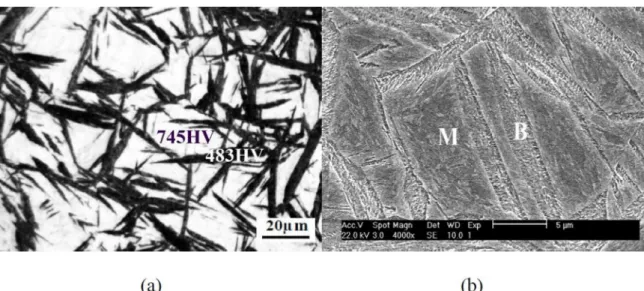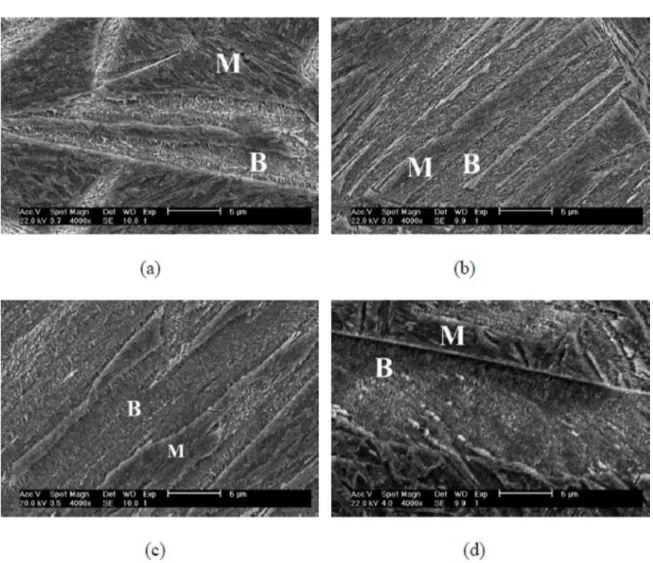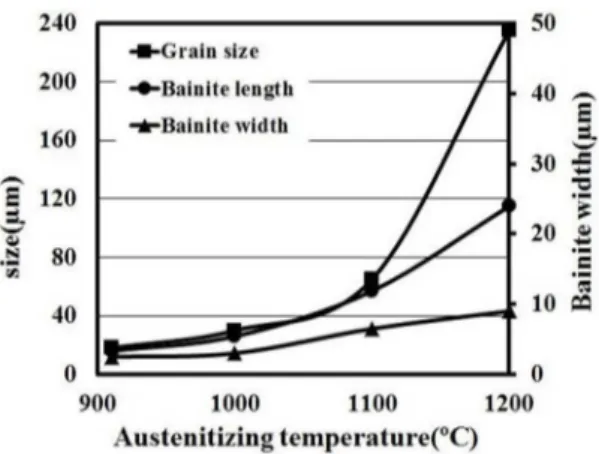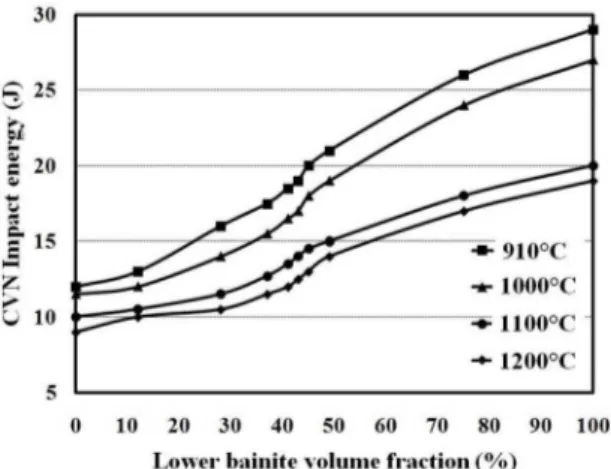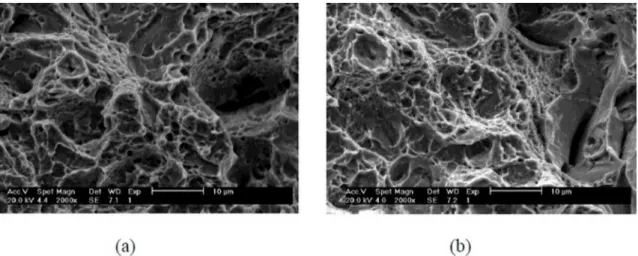Effect of Austenitizing Temperature on Mechanical Properties of the Mixed Bainite -
Martensite Microstructure in CrMoV Steel
Parsa Abbaszadeha*, Shahram Kheirandisha, Hassan Saghafiana, Mohammad hossein Goodarzya
Received: May 05, 2017; Revised: September 23, 2017; Accepted: October 05, 2017
The effect of austenitizing temperature on mechanical properties of the mixed bainite - martensite microstructure in CrMoV steel was studied in the present work. The result showed that at low austenitizing temperature (910°C - 1000°C), the mixed microstructures containing 12-28% volume fraction of lower bainite showed higher yield and tensile strength than fully martensitic microstructure. The partitioning of the prior austenite grain by lower bainite was found to cause a refinement of the martensite packet size. In addition the strength of the lower bainite in the mixed microstructure is enhanced by plastic constraint induced by the surrounding stronger martensite. By increasing the austenitizing temperature from 1000°C to 1200°C (40min), the YS, UTS, %EL, %RA and CVN impact energy decreased for all samples. This is attributed mainly to the increase in austenite grain size and width of bainite sheaves.
Keywords: Microstructure, CrMoV, Mechanical properties, lower bainite
*e-mail: eurak@alumni.iust.ac.ir
1. Introduction
Ultrahigh strength medium carbon low alloy CrMoV(D6AC) steel has been used as a structural material for several critical applications such as landing gears, shafts and motor cases, etc. It has good notch toughness and does not exhibit temper embrittlement1.
Quenching followed by tempering process is the most common heat treatment cycle for the hardening and strengthening of ultrahigh strength medium carbon low alloy steels2. However, increase in strength is usually associated
with decrease in the ductility values limiting the structural applications of these steels3,4. An approach to overcome this
problem is to develop steels, having mixed or multiphase microstructures5-8. However, inferior mechanical properties
have also been reported for these steel compared with those having conventional microstructures8.
Salami et al.9,10 reported that the mechanical properties
of tempered martensite are more favorable than those of ferrite - bainite - martensite microstructure in 42CrMo4 steel. They demonstrated that the high density of interphase boundary in ferrite - bainite - martensite microstructure was the main reason for the inferior mechanical properties of such a mixed microstructure.
Tomita et al.11 suggested that the lower bainite which
appears in acicular form and divides the prior austenite grain, which is associated with martensite, provided a better combination of mechanical properties in AISI 4340 Steel. On the other hand the mixed microstructure of upper bainite - martensite significantly lowers mechanical properties compared to the martensitic microstructures12-14. Contrary
to the Tomita investigation, Rao et al.15 suggested that the
presence of the upper bainite in the mixed microstructure in an AISI 4330V led to a significant improvement in toughness without affecting the strength of the fully martensitic microstructure. However no beneficial effect of the lower bainite on mechanical properties was observed in the lower bainite- martensite microstructure. The above survey of literature serves to show the complex effects of the mixed or multiphase microstructures on mechanical properties of ultra high strength low alloy steels. Because of lack of any report regarding the effect of austenitizing temperature on the mechanical properties of the mixed lower bainite - martensite microstructure, the current work was undertaken to study of the effect of austenitizing temperature on the mechanical properties of the mixed lower bainite - martensite microstructure in CrMoV steel.
2. Experimental Procedure
The CrMoV steel was received as forged bars which were 85mm in diameter. The chemical composition of the steel is given in Table 1.
Test plates of 60mm × 130mm with a thickness of 6 and 12mm were cut from the steel bars. The length of the plates was in the longitudinal direction of the bar. Each plate was first stress relieved at 650ºC and then fully annealed at 850 ºC for 2hrs. The austenitizing was carried out in an argon atmosphere furnace with a temperature accuracy of ±4ºC at different temperatures of 910ºC, 1000ºC, 1100ºC and 1200ºC for 40min. Following the austenitizing, specimens were either oil quenched to produce martensite, or isothermally held in a salt bath of 330 ºC above the MS for different holding
times (3.5, 5, 7.5, 10, 12.5, 15, 20 and 840 min) then oil
aCenter of Excellence for Advanced Materials and processing (CEAMP), School of Metallurgy and
quenched to obtain mixed microstructure of lower bainite - martensite with varying amounts of the lower bainite. A fully lower bainite microstructure was obtained by quenching the specimens in a salt bath at 330 ºC for 24 hrs. Finally, all specimens were tempered at 200ºC for 2hrs.
After heat treatment, the plates were machined and ground to the final thicknesses of 4 and 10mm to eliminate any decarburized layer. Sub size tensile specimens which are 4mm thick with a gauge length of 25mm were wire cut from a plate which is 4mm thick in accordance with ASTM E8M16.
Charpy V - notch impact specimens were wire cut from a plate which is 10mm thick in accordance with ASTM E2317.
Tensile tests were carried out using a 200KN electromechanical universal machine at constant cross- head speed of 5mm/min. The charpy V - notch impact properties were determined using a 300J metal pendulum impact machine. A minimum of seven impact and three tensile specimens were tested in each case. The microstructures were examined by optical and scanning electron microscopes. Metallography specimens were cut from the impact test pieces. The specimens were etched with hot (75ºC) supersaturated aqueous solution of picric acid to reveal the prior austenite grain size. In order to reveal the lower bainite in a matrix of martensite, the specimens were etched with a solution of 4wt. % picral plus 1wt. %HCL18. Volume fractions of the lower bainite were
determined by clemex vision image analysis software based on the difference in color between lower bainite (dark) and martensite (white). At least 5 representative areas in each sample were studied through metallographic evaluations. The X-Ray diffraction technique was employed by using CuKα radiation to detect retained austenite19. The fracture
surfaces of impact specimens were examined by scanning electron microscopy (SEM) in order to characterize the impact fracture mode.
3. Results and Discussion
3.1. Metallographic observations
Figure 1 shows typical optical and scanning electron micrographs of the mixed lower bainite - martensite microstructures after austenitizing at 910°C. Fig.1a shows optical micrographs of the mixed microstructure of the lower bainite - martensite, in which the dark etched regions correspond to lower bainite and the white regions corresponding to martensite. Micro hardness tests showed that the hardness values of dark regions (lower bainite) and white regions (martensite) are 483 and 745 HV, respectively and confirm the metallography observation. Corresponding scanning electron micrographs of the mixed microstructure of the lower bainite - martensite (Fig.1b) reveals that the lower bainite associated with martensite appears in acicular form and partitions the prior austenite grains, therefore refines the martensite packet size. This type of microstructures is similar to the one reported by Wen et al.20 and Wang et al.21.
Figure 2 shows typical scanning electron micrographs of the mixed lower bainite - martensite microstructures after austenitizing at 910°C - 1200°C. It is evident that by increasing austenitizing temperature both thickness and length of the bainite sheaves were increased. The variation of microstructural factors as a function of austenitizing temperature were quantitatively established and shown in Table 1. Chemical composition of Cr MoV steel (Wt. %).
Element C Si Mn P S Cr Mo Ni V Fe
Wt. % 0.47 0.26 0.76 0.009 0.004 0.99 0.93 0.54 0.11 Bal.
figure 3. As expected, during the austenitizing process, the prior austenite grain size increased with increasing austenitizing temperature, for example about 18µm at 910°C and nearly 235µm at 1200°C. Also the bainite length and width was increased in the range of 16-115µm and 2.5-9µm for samples austenitized at 910°C to 1200°C, in which the average error for grain size, bainite length and bainite wedth are ±3 µm, ±2µm and ±1µm, respectively.
Chakraborty et al.22 reported that refinement of the austenite
grains led to enhancement of the heterogeneous nucleation rate of bainite but the extent of the overall transformation was limited by a slow growth rate. In other words, lowering of the prior austenite grain size may generate additional nucleation sites for bainite and enhance nucleation rate, but restrict the growth of ferritic sheaves by grain boundaries. They have suggested that the growth of bainite is retarded when austenite grains are finer22. Therefore as shown in Fig.2,
the bainite width increased by increasing the austenitizing temperature.
3.2. Mechanical properties
In order to study the effect of lower bainite - martensite mixed microstructure on the mechanical properties of the CrMoV steel, tensile and impact tests were conducted. The tensile and impact specimens were contained 0 (a fully martensitic microstructure), 12, 28, 37, 41, 43, 45, 49, 75 and 100 (a fully bainitic microstructure) volume pct lower bainite. Variations of yield and tensile strength in terms of the lower bainite volume fraction are shown in figures 4 and 5, in which the average error for yield and ultimate tensile strengths are ±10 MPa and ±15 MPa, respectively. According to the rule of mixtures (equation 1), yield strength of mixed lower bainite - martensite microstructure decreases linearly with the increase in the volume fraction of lower bainite, because the yield strength of martensite microstructure is higher than the yield strength of bainite microstructure5.
(1)
Figure 2. Scanning electron (SEM) micrographs of mixed lower bainite - martensite microstructures, austenitized at (a) 910°C (b) 1000°C (c) 1100°C (d) 1200°C.
V
V
1
yMix y M
B y B
B
Figure 3. Variation of microstructural factors as a function of austenitizing temperature.
Figure 4. Variation of yield strength with amount of the lower bainite for various austenitizing temperatures.
kS m
.y M
i
0 5
v
=
v
+
-the yield strength of -the samples austenitized at 910°C and 1000°C increases and attains about 1869MPa and 1807MPa, respectively and then decreases to the strength level of a fully lower bainitic samples.
As seen in Fig.1, the formation of lower bainite partitions the prior austenite grains and therefore, decreases the martensite packet sizes. According to the Hall - petch relationship, equation (2), decreasing the martensite packet size increases the strength of the martensite microstructure.
(2)
Where σy
M is yield strength of martensite in the mixed
microstructure, σi is frictional stress, k is constant, and Sm
is the distance between the initial grain boundary and the second phase, e.g. the martensite packet size12. In addition
the strength of lower bainite in mixed microstructure was increased by plastic constraint induced by the surrounding stronger martensite. Yong and Behadeshia23 demonstrated
that the yield strength is increased by plastic constraint, upon which a soft thin layer can be constrained by the hard matrix surrounding it. For example a weak brazing alloy can be used effectively to bond much stronger specimens provided that the brazing material is thin enough to be constrained by the surrounding stronger matrix. Indeed the strength of the joint increases as the thickness of the brazing layer decreases. The same phenomenon occurs when the lower bainite plates form in the austenite which subsequently transforms to much stronger martensite. In other words the bainite plate plays the role of soft layer. On the other word, the presence of a peak at about 28 vol. % lower bainite in the curve of strength as a function of lower bainite volume fraction can be attributed to the improvement in the strength of martensite due to the refinement of its substructure that is caused by partitioning of the prior austenite grains by the lower bainite. In addition the strength of lower bainite was increased by plastic constraint induced by the martensite. However this is not the case for the samples austenitized at temperatures higher than 1000°C. Decreasing the mechanical properties with the increase of the austenitizing temperature may be attributed to the formation of coarser prior austenite grains as shown in fig.3, and in turn, formation of coarser martensite packets. However increasing the austenitizing temperature from 1100°C - 1200°C causes yield and tensile strength of the mixed microstructure of lower bainite - martensite to become less than the martesitic microstructure. As explained in section 3.1, increasing the austenitizing temperature causes increase in bainite width. According to Eq.3, increasing the bainite width (L3) decreases
the yield and tensile strength of the mixed microstructure of lower bainite - martensite in comparison with the single phase martensite microstructure22,24.
(3) K L3 K / K
Fe C ss 1 d
1 2
1 2 3
1
v=v +v +
/
v + Q V- + t + D-Figure 5. Variation of tensile strength with amount of the lower bainite for various austenitizing temperatures.
Where σy
Mix is yield strength of lower bainite - martensite
mixed microstructure, σy M and σ
y
B are yield strength of
martensite and lower bainite microstructure, respectively. On comparison, in the present experimental results, σy
Mix
where σFe is the strength of pure annealed iron, σC is the
contribution of solid solution strengthening due to carbon, ΣσSS is the summation of solid solution strengthening due to
all substitutional solutes, L3 is the ferrite plate thickness, ρd is
the dislocation density, Δ is the distance between the carbide particles (or precipitates) and K1, K2, K3 are constants
22,24.
The variations of elongation, reduction of area and charpy impact energy with austenitizing temperature for various microstructures obtained from different heat treatment cycles are shown in figures 6 - 8, respectively. As shown, at constant austenitizing temperature, ductility and impact toughness increased by increasing the lower bainite volume fraction. This improvement in ductility and impact toughness is not because of retained austenite. X-Ray difraction patterns have not shown difraction peaks at (200)γ, (220)γ, (113)γ, (222)γ, (004)γ. As these peaks were not found in XRD patterns of specimens, it is speculated that the amount of retained austenite was not sufficient enough to be detected19. Thus, this amount of retained
austenite has no significant effect on the mechanical properties of various microstructures. Thus, the tensile and impact tests show that lower bainite is more ductile and tougher than martensite microstructure. On the other hand, in mixed lower bainite - martensite microstructure, a crack propagated within the martensite will be blunt when reaching the more flexible lower bainite plates and therefore the impact energy increases. This is because lower bainite brings into full play the arresting effect of the crack and stress - relief, as a result of deformation in association with martensite. From Figure 9 microcracks are found behind the fracture surfaces of impact specimens having mixed lower bainite - martensite microstructure. It can be seen from Figure 9a and 9b microcracks stoped by dimple rigions (lower bainite area). This suggests that lower bainite is responsible for the increased impact toughness. Typical SEM images of the impact fracture surface of samples after austenitized at 910°C are shown in Figure 10a - 10e. Figure 10a reveals that a crack in martensitic samples propegated in a brittle manner, producing cleavage and quasi- cleavage facets. The results are consistent with low impact toyghness of martensitic samples. The impact fracture morfology in mixed lower bainite - martensite microstructure samples was a mixed mode of dimple rupture and quasi - cleavage. However, by increasing the lower bainite volume fraction (Fig.10b - Fig.10d), the samples exhibited more dimple rupture. On the other hand, the fracture morphology change from mixed mode of dimple rupture and quasi - cleavage in mixed microstructure samples (Fig.10b - Fig.10d) to fully dimple rupture in fully lower bainitic sample (Fig.10e). Therefore, as shown in Fig.8, by incresing the lower bainite volume fraction, the impact toughness is increaesed. Also, the fully lower bainitic sample has higher impact absorbed energy than the othere samples. The superior impact toughness and ductility of the lower bainite compared with martensite in Q&T condition samples were also found in the earlier studies25. But, it is noteworthy that this is only observed when
lower bainite is formed through an isothermal transformation. The mixed microstructures of bainite - martensite formed by continious cooling and slack quenching have lower toughness than martensitic microstructures8. Howevre, by increasing
the austenitizing temperature in the range 910°C - 1200°C, elongation, reduction of area and charpy impact energy decreases for all microstructures. Since this decrease is observed for all microstructures, it is expected that the austenite grain size is primarily responsible for controlling ductility and impact toughness due to variation in austenitizing temperature26.
Figure 6. Influence of amount of the lower bainite on elongation of specimens austenitized at different temperatures.
Figure 7. Influence of amount of the lower bainite on reduction area of specimens austenitized at different temperatures.
Figure 9. Scanning electron micrograph (SEM) of microcrack being initiated during charpy impact testing of specimen having 49% lower bainite.
4. Conclusions
1. A maximum point was observed in the curve of strength as a function of the lower bainite. This can be explained on the basis of two factors. The first is an increase in the strength due to the partitioning of the prior austenite grains by the lower bainite resulting in the refinement of martensite substructures. The second is a plastic constraint effect leading to an enhanced strength of the lower bainite induced by the surrounding relatively rigid martensite. 2. By increasing the volume fraction of lower bainite,
the elongation, reduction area and charpy V - notch impact energy increased for all austenitizing temperature because of significantly greater ductility and impact toughness of lower bainite compared with martensite.
3. The impact fracture surface of martensitic and lower bainitic samples exhibited cleavage and dimple rupture, respectively. However the fracture morfology in mixed lower bainite - martensite microstructure samples was a mixed mode of dimple rupture and qusi - cleavage.
4. By increasing austenitizing temperature from 1000°C to 1200°C (40min), the YS, UTS, %EL and CVN impact energy decreases for all samples and no peak is observed in the curve of the strength as a function of the lower bainite volume fraction for samples austenitized at high temperature (1100°C - 1200°C). This is attributed mainly to the increase in austenite grain size and width of bainite sheaves.
5. References
1. Chang TL, Tsay LW, Chen C. Influence of gaseous hydrogen on the notched tensile strength of D6ac steel. Materials Science and Engineering: A. 2001;316(1-2):153-160.
2. Varshney A, Sangal S, Kundu S, Mondul K. Super strong and highly ductile low alloy multiphase steel consisting of bainite, ferrite and retained austenite. Materials & Design.
2016;95:75-88.
3. Huang W, Liu W, Huang Y, Chen H, Huang W. Effect of a quenching-long partitioning treatment on the microstructure and mechanical properties of a 0.2C% bainitic steel. Journal of Materials Processing Technology. 2015;222:181-187.
4. Zhao J, Zhao T, Hou CS, Zhang FC, Wang TS. Improving impact toughness of high-C-Cr bearing steel by Si-Mo alloying and low-temperature austempering. Materials & Design.
2015;86:215-220.
5. Baradari S, Boutorabi SM. Effects of isothermal transformation conditions on the microstructure and hardness values of a high-carbon Al-Si alloyed steel. Materials & Design.
2015;86:603-609.
6. Rastegari H, Kermanpur A, Najafizadeh A. Investigating the effects of short time austenitizing and cooling rate on pearlitic microstructure and mechanical properties of a hot rolled pain eutectoid carbon steel. Materials & Design. 2015;67:217-223.
7. Li Y, Chen X. Microstructure and mechanical properties of austempered high silicon cast steel. Materials Science and Engineering: A. 2001;308(1-2):277-282.
8. Zhang XZ, Knott JF. Cleavage fracture in bainitic and martensitic microstructure. Acta Materialia. 1999;47(12):3483-3495.
9. Salemi A, Abdollah-Zadeh A, Mirzaei M, Assadi H. A study on fracture properties of multiphase microstructures of CrMo steel.
Materials Science and Engineering: A. 2008;492(1-2):45-48.
10. Abdollah-Zadeh A, Salemi A, Assadi H. Mechanical behavior of CrMo steel with tempered martensite and ferrite-bainite-martensite microstructure. Materials Science and Engineering: A. 2008;483-484:325-328.
11. Tomita Y. Improved lower temperature fracture toughness of ultrahigh strength 4340 steel through modified heat treatment.
Metallurgical Transactions A. 1987;18(8):1495-1501.
12. Tomita Y, Okabayashi K. Improvement in lower temperature mechanical properties of 0.40 pct C-Ni-Cr-Mo ultrahigh strength steel with the second phase lower bainite. Metallurgical Transactions A. 1983;14(2):485-492.
13. Tomita Y, Okabayashi K. Heat treatment for improvement in lower temperature mechanical properties of 0.4 pct C- Cr- Mo ultrahigh strength steel. Metallurgical Transactions A.
1983;14(11):2387-2393.
14. Tomita Y, Okabayashi K. Modified heat treatment for lower temperature improvement of the mechanical properties of two ultrahigh strength low alloy steels. Metallurgical Transactions A. 1985;16(1):83-91.
15. Rao TVLN, Dikshit SN, Malakondaiah G, Rao PR. On mixed upper bainite-martensite in an AISI 4330 steel exhibiting an uncommonly improved strength-toughness combination. Scripta Metallurgica et Materialia. 1990;24(7):1323-1328.
16. ASTM E8 - Test Method for Tension Testing of Metallic Material. In: Annual Book of ASTM Standards. Philadelphia:
ASTM International; 1998.
17. ASTM E23 - Test Method for Notched Bar Impact Testing of Metallic Material. In: Annual Book of ASTM Standards.
Philadelphia: ASTM International; 1998.
18. Bramfitt BL, Benscoter A. Metallographer's Guide: Practices and Procedures for Iron and Steels. Materials Park: ASM
International; 2002.
19. Magner SH, de Angelis RJ, Weins WN, Makinson JD. A historical review of retained austenite and its measurement by X-ray diffraction. Advances in X-ray Analysis. 2002;45:92-97.
20. Wen J, Li Q, Long Y. Effect of austempering on microstructure and mechanical properties of GCr18Mo steel. Materials Science and Engineering: A. 2006;438-440:251-253.
21. Wang TS, Yang J, Shang CJ, Li XY, Zhang B, Zhang FC. Microstructures and impact toughness of low-alloy high-carbon steel austempered at low temperature. Scripta Materialia.
22. Chakraborty J, Bhattacharjee D, Manna I. Development of ultrafine bainite + martensite duplex microstructure in SAE 52100 bearing steel by prior cold deformation. Scripta Materialia.
2009;61(6):604-607.
23. Yong CH, Bhadeshia HKDH. Strength of mixtures of bainite and martensite. Materials Science and Technology.
1994;10(3):209-214.
24. Chakraborty J, Bhattacharjee D, Manna I. Austempering of bearing steel for improved mechanical properties. Scripta Materialia. 2009;59(2):247-250.
25. Tartaglia JM, Lazzari KA, Hui GP, Hayrynen KL. A Comparison of Mechanical Properties And Hydrogen Embrittlement Resistance of Austempered vs Quenched and Tempered 4340 Steel.
Metallurgical and Materials Transactions A.
2008;39(3):559-576.
